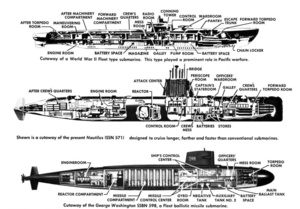| Submarine | |
|---|---|
 US Virginia-class submarine underway in Groton, Connecticut, July 2004 | |
| Classification | Watercraft |
| Industry | Arms |
| Application | Underwater warfare |
| Inventor | Cornelis Drebbel[1] |
| Invented | 1620 |


- World War II fleet submarine (Gato, Balao or Tench class), commissioned 1941–1945
- The first nuclear-powered submarine USS Nautilus (SSN-571), commissioned 1954
- The first ballistic missile submarine USS George Washington (SSBN-598), commissioned 1959
A submarine (or sub) is a watercraft capable of independent operation underwater. (It differs from a submersible, which has more limited underwater capability.)[2] The term “submarine” is also sometimes used historically or informally to refer to remotely operated vehicles and robots, or to medium-sized or smaller vessels (such as the midget submarine and the wet sub). Submarines are referred to as boats rather than ships regardless of their size.[3]
Although experimental submarines had been built earlier, submarine design took off during the 19th century, and submarines were adopted by several navies. They were first used widely during World War I (1914–1918), and are now used in many navies, large and small. Their military uses include: attacking enemy surface ships (merchant and military) or other submarines; aircraft carrier protection; blockade running; nuclear deterrence; stealth operations in denied areas when gathering intelligence and doing reconnaissance; denying or influencing enemy movements; conventional land attacks (for example, launching a cruise missile); and covert insertion of frogmen or special forces. Their civilian uses include: marine science; salvage; exploration; and facility inspection and maintenance. Submarines can be modified for specialized functions such as search-and-rescue missions and undersea cable repair. They are also used in the tourism industry and in undersea archaeology. Modern deep-diving submarines derive from the bathyscaphe, which evolved from the diving bell.
Most large submarines consist of a cylindrical body with hemispherical (or conical) ends and a vertical structure, usually located amidships, which houses communications and sensing devices as well as periscopes. In modern submarines, this structure is called the "sail" in American usage and "fin" in European usage. A feature of earlier designs was the "conning tower": a separate pressure hull above the main body of the boat that enabled the use of shorter periscopes. There is a propeller (or pump jet) at the rear, and various hydrodynamic control fins. Smaller, deep-diving, and specialty submarines may deviate significantly from this traditional design. Submarines dive and resurface by using diving planes and by changing the amount of water and air in ballast tanks to affect their buoyancy.
Submarines encompass a wide range of types and capabilities. They range from small, autonomous examples, such as one- or two-person subs that operate for a few hours, to vessels that can remain submerged for six months, such as the Russian Typhoon class, (the biggest submarines ever built). Submarines can work at depths that are greater than what is practicable (or even survivable) for human divers.[4]
- ^ Fontenoy (2007), p. 1.
- ^ "Marine Biologist and Bioluminescence Specialist Edith A. Widder: Video Transcript: Ocean Exploration Careers: NOAA Office of Ocean Exploration and Research".
- ^ Cutler, Thomas J. (1 October 2017). "Of Ships and Boats and ..." Bluejacket's Manual. Naval History. Vol. 31, no. 5. U.S. Naval Institute. Retrieved 9 November 2022.
- ^ Sherman, Chris (14 April 2009). "Worlds Biggest Submarine". English Russia. Retrieved 21 May 2013.